#i hope you like it varshi!!!
Explore tagged Tumblr posts
Note
28 and 35? 💕
28. “You’re being dramatic.”
35. “Have you ever heard of personal space?”
“You don’t have to go there if you don’t want to,” Even said as he sat on the couch reading some news article on his phone. “Like, nobody is forcing you.”
“Lea is my sister, Even,” he reasoned. “If she’s getting married, then I have to go.”
Even sighed and sat his phone down on the couch. “I thought that you liked this guy,” he argued. “When you visited her you said that he was very nice.”
“He is nice, Even. He’s fucking amazing and she’s perfect. That’s why I have to go,” he said frantically.
Even furrowed his eyebrows. “Then I’m not sure that I really understand what the problem here is.”
Isak didn’t know how his boyfriend could be so fucking blind. “She’s perfect and I’m gay,” he stated.
His boyfriend blinked for a few moments. “Isak, I think you’re being dramatic.”
“Dramatic?!” he exclaimed, throwing his hands up into the air. “I am not being dramatic. In fact, if anything, you’re downplaying the entire situation.”
“Being gay doesn’t make you any less perfect,” Even reasoned.
Isak crossed his arms. “I know that, obviously. But does my family think the same thing?”
Even hauled himself up off of the couch and made his way over to Isak. “Does it really matter what they think?” he asked before running his fingers through Isak’s hair.
Yes, it absolutely did matter what his family thought of him. Isak lightly shoved his boyfriend away.
“Have you ever heard of personal space?” he retorted. Even back up a few steps and kept his arms at his sides. Isak didn’t want to be touched right now and Even understood and accepted that.
“I just think that you don’t need to focus so much on what other people think,” Even said softly, as not to make things worse. “You know who you are and I know who you are. You’re amazing and that’s what really matters.”
“I just want to them to love me for me,” Isak replied quietly. “And I want them to see what a fantastic guy you are.”
“Maybe they will,” he pointed out. “But there’s only one way to know for sure. You need to face your fears and show them how fucking in love we are.”
Isak bit his lip and looked up at his boyfriend. “Okay,” he started, “I think that I might be ready for a hug now.”
Even stepped forward and wrapped him in his arms. Isak had never truly felt loved until he met Even and he supposed that, if people couldn’t see it, then their opinion didn’t really matter anyway.
17 notes
·
View notes
Text
Ganapati - Once and Future Leader
In which Harsha Prabhu follows in the footsteps of the Elephant-headed God and bumps into some inconvenient truths
"Vakratunda Mahakaaya, Suryakoti Samaprabha Nirvighnam Kuru Mey Deva, Sarva Kaaryeshu Sarvada"
Ganesh Mantra
(The lord with the curved trunk and a mighty body, with the luster of a million suns I pray to thee, to remove all obstacles from my path)
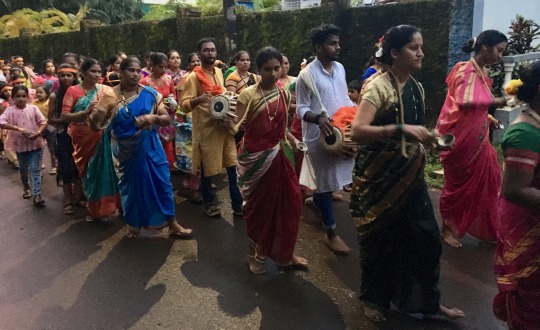
Ganapati procession, Arambol, Goa, September 2019. Pic: Harsha Prabhu
Arambol, Goa September 2019
Bhajan Mandali
Ganapati, aka Ganesh, the elephant-headed god, has many devotees among the Hindu community in India. Many Hindu households install an image of the god and offer prayers, conduct rituals and invite their neighbours for a darshan (viewing) of the god and share lunch or at least prasad (ritual offerings) together.
In the evenings, groups of musicians (mandali) go from house to house and sing bhajans (devotional songs) in his honour.
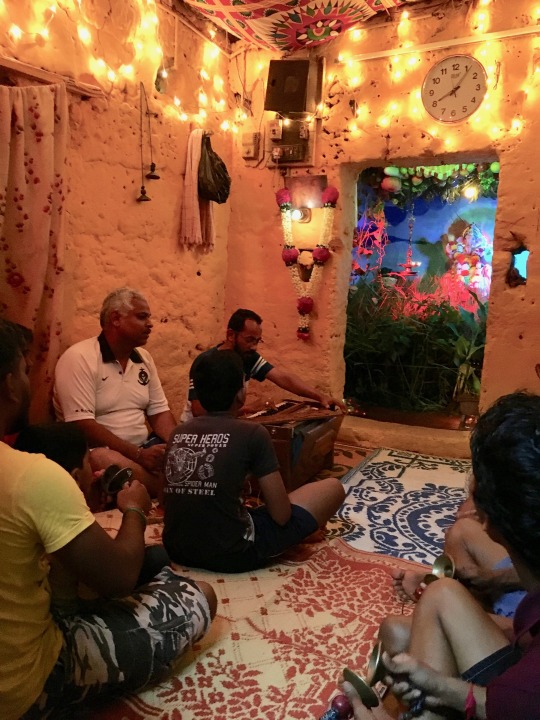
Bhajan mandali at a house in Arambol. Pic: Harsha Prabhu
One night in Arambol, I visited five households with a bhajan mandali. Apart from hymns to Ganapati there were many abhangas (songs) composed by Tukaram, the Marathi Bhakti poet-saint, beloved of the people.
The singing sessions were robust; the tea, coffee, fruit and snacks provided by every household plentiful. In one house we went to, the owner locked the doors to ensure that we finished all the food and drink he had to offer. What with the round of lunches and snacks, my midriff began to resemble the ample girth of Ganapati.
After a set number of days - anywhere between two and twenty one - these Ganapati idols are immersed (visarjan) in the sea or any available waterbody.
Sarvajanik Ganapati
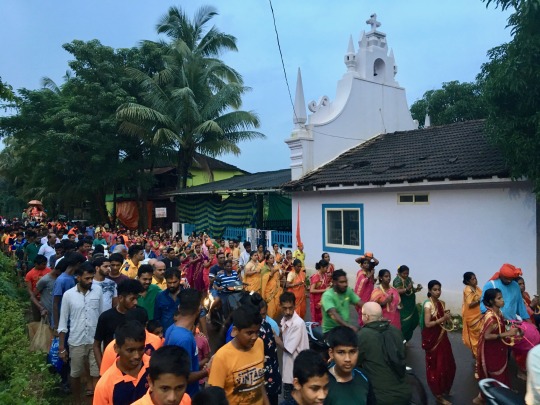
Ganapati procession, Arambol. Pic: Harsha Prabhu
Besides these household Ganapatis, there’s also the Sarvajanik Ganpati, a ‘people’s Ganapati,’ that is set up in a public place for the community to worship.
Last Thursday this Sarvajanik Ganapati - which was on show at a public hall in the village - was set atop a pick up truck and wound his way through the main street of Arambol to the sea shore. He was accompanied by singing and dancing women - resplendent in their traditional, nine-yard sarees, nose rings and other accoutrements - and children and men playing drums. Along the way groups of young boys lit firecrackers.
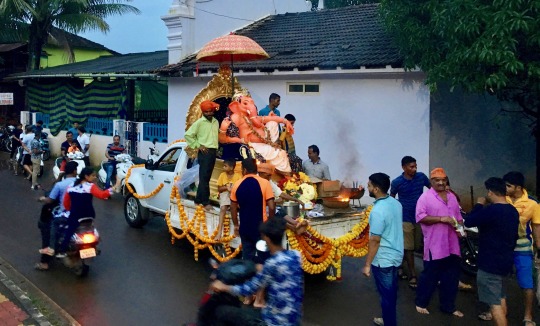
Ganapati procession, Arambol. Pic: Harsha Prabhu
To escape breathing the fumes from the firecrackers and the loud explosions they made, I made my way down to the beach. The sun was about to set; the tide was coming in.
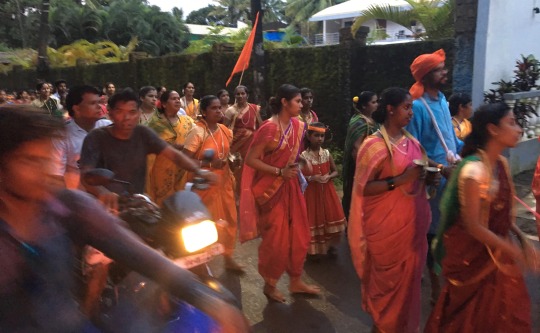
Ganapati procession, Arambol. Pic: Harsha Prabhu
Soon groups of women descended on the beach. These were the singers and dancers from the street parade. I began to notice what sounded like a low murmur enveloping the beach. At first I couldn’t work out where the sound was coming from. Then I realised it was coming from the gathered women. They must have all been whispering prayers under their breath. It sounded like the humming of bees.
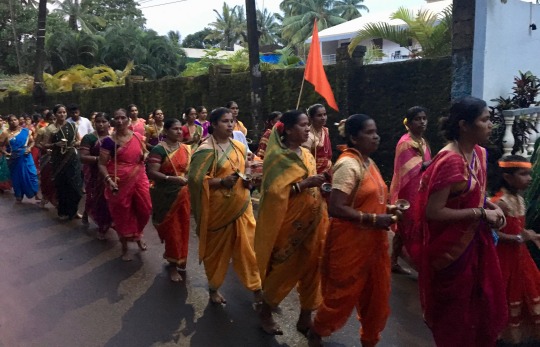
Ganapati procession, Arambol. Pic: Harsha Prabhu
Then the truck with the Ganapati appeared and manoeuvred on the sand. More prayers, more dancing by the women and drumming by the men. Fireworks lit the now-dark sky.
A simple prayer was read out in Marathi, expressing the humble hopes of the people: As in past years we have been worshiping you. Please forgive us for any misdemeanors on our part. Please help children gain knowledge through education. Please also help all people get jobs and become healthy and wealthy. Please bless everybody.
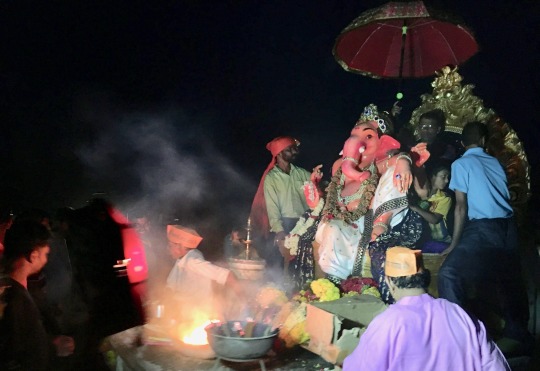
Ganapati visarjan, Arambol. Pic: Harsha Prabhu
Then, with shouts of “ Ganpati Bappa Morya, pudhcha varshi loukar ya” (Hail Father Ganapati, come back soon next year), a bunch of men lifted the idol from the truck and walked him into the sea. The incoming tide pushed the watching worshipers to higher ground. Thus ended this year’s Ganapati celebrations in Arambol.

Ganapati visarjan, Arambol. Pic: Harsha Prabhu
Leaving the beach, I heard one young man tell his friend: “Ganapati has gone. Now we can eat fish.”
This was a reference to the fact that, for the period of Ganapati’s stay in the village, Goa’s Hindus refrain from eating fish or meat of any sort, or even eggs - a big sacrifice for people for whom fish is a dietary staple.
I thought to myself: Goa’s fish better watch out.

Ganapati visarjan, Arambol. Pic: Harsha Prabhu
Ganapati - a potted history
I am indebted to the work of Debiprasad Chattopadhyaya, Marxist philosopher and historian, for much of what follows. Errors in interpretation are my own.
In his landmark book, Lokayata: A Study in Ancient Indian Materialism, Chattopadhyaya uncovers the tangled web of the Ganapati story, following its twists and turns, marking the vicissitudes of the rise and fall and subsequent rise of Ganapati.
Ganapati means leader/father (pati) of the tribe or group (gana) in Sanskrit.
Clearly, Ganapati is very old, a totemic figure from India’s tribal past.
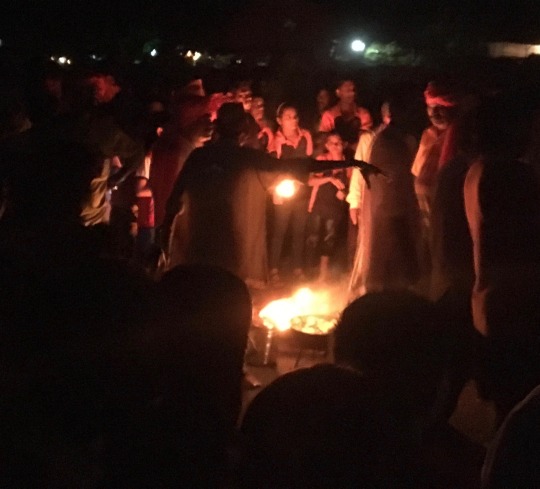
Ganapati visarjan, Arambol. Pic: Harsha Prabhu
Ganapati is mentioned in the Rig Veda (1200 - 900 BCE) as "the seer among the seers, abounding beyond measure in food, presiding among the elders and being the lord of invocation.”
In the Rig Veda, however, Ganapati refers to a person and there are many Ganapatis, described as leaders of different groups or tribes. “Ganesvaras, or Ganapatis, and Vinayakas are here represented as…many in number and present everywhere” (Bhandarkar). What’s more, the Rig Vedic Ganapati has not yet received his iconic elephant head.
Sakti Ganapati
Chattopadhyaya suggests that Ganapati is associated with the early agricultural tribal society that predates the time of the Vedas. He connects it with fertility rituals to do with mother goddess worshiping cultures.
Chattopadhyaya mentions how In some parts of India, Ganapati-worship is followed by the worship of Gauri, the mother goddess, and is connected with rituals to do with the new moon and the sowing cycle, where the goddess is depicted as “a bundle of plants, along with her human representative - a virgin.”
(I saw a remnant of this in Goa. Just before my neighbour’s household Ganapati was whisked away by the men to be immersed in the sea, the matriarch of the house ran out of the house with a sheaf of plants and blessed the idol, saying “Gauri, Gauri.”)
According to Chattopadhyaya, Ganapati is also a key figure in Tantric rituals. There are 50 different names for Ganapati in Tantric literature; and some of the followers of Ganapati (e.g. Ucchista Ganapati) were also ‘vamacaris’, ‘tantrics,’ who practiced ritual group sex.
There are also female versions of Ganapati, know as Vinayaki, shown with the head of an elephant and the body of a youthful woman (Silparatna, 16th century). These too may have Tantric origins. Similarly, the Buddhist Hevajra Tantra mentions an elephant-headed goddess, Ganaptihrdya.
Then there are the Sakti Ganapatis, where Ganapati is shown embracing a female, where the male god is depicted as being subordinate to the goddess. Chattopadhyaya points to the idol in the famous Ellora caves, where Ganesa is “subservient to the seven women, called the seven mothers (sapta matrikas).”

Ganapati procession, Arambol. Pic: Harsha Prabhu
Ganapati as trouble-maker
The patriarchal backlash was predictable.
Perhaps because of this heterodox, tribal, matriarchal and Tantric connection, in the Griha Sutras (500 BCE), commentaries on the Vedas, we find Ganapati inspires dread: a follower of Ganapati “…sees in dreams waters, men with shaved heads, camels, pigs, asses…”
The Upanishadic Brahmin sage Yajnavalkya (8th-7th century BCE) saw Ganapati in the same vein: “Being possessed of Ganapati, the Princes Royal do not obtain the kingdom.”
Chattopadhyaya’s masterly analysis - combining comparative history and anthropology - shows the Ganapati story to run parallel to the destruction of tribal society in India and the rise of monarchies and centralised state power, buttressed by the panegyrics of patriarchal Brahminism as an ideological force providing the social glue to cement the status quo, including caste discrimination.
No doubt that’s why the Manusmriti, the Lawbook of Manu (2nd century BCE - 3rd century CE), a Brahmanical text, looks down upon Ganapati. Says Chattopadhyaya: ’A couplet ascribed to him (Manu) describes Ganapati as the deity of the depressed classes, the Sudra, and this in clear contrast to Sambhu, the deity of the Brahmanas, and Madhava, the deity of the Ksatriyas.’
Indeed, many of the names of Ganapati - Vignakrit, Vignaraja, Vigneshwara - suggest this adverse history. ‘Vigna’ means ‘trouble’ in Sanskrit.
Trouble-maker Transformed
How did the Vignakrit, ‘trouble-maker’, become today’s remover of trouble?
The transformation of a radical force into its opposite is a tribute to the powers of co-option exercised by the ruling classes in all societies, but is a special hallmark of Indian culture. It’s always the winners in the culture wars that shape the narrative, that write the history books.
One way of doing this is to make room for this radical figure of popular appeal - originally a person, then a totem, now a god - and include him in the premier pantheon of the gods. Again, Indians are masters of this kind of mystification and cultural assimilation.
Thus, a whole back-story is created for Ganapati, including how he got his elephant’s head, and a new lineage, wherein he becomes the child of Shiv and Parvati, and is admitted into the mainstream Hindu canon of worship.
It’s a classic tale of the absent father, Shiva, who does not recognise his son, Ganapati, who is guarding his mother, Parvati, while she bathes. The father beheads his son; but then relents on discovering his true identity and crowns him with the head of an elephant. It’s your typical Oedipal story, but with a happy ending, worthy of Bollywood.
Far from seeing him as a trouble-maker, the medieval Puranas - especially Skanda Purana, Narada Purana and the Brahma Vaivarta Purana - are full of hyms praising Ganapati.
Chattopadhyaya, quoting A K Coomaraswamy, tells us the elephant-headed version of Ganapati that we are familiar with appears around the time of the Guptas, in 5th century CE. Before this, Ganapati is shown with other heads, including bull and snake heads, again betraying his tribal, totemic origins.
Inconvenient Truth
Still, some inconvenient truths remain to be explained.
One of the names of Ganapati is Ekadanta, ‘one-tusked’, and he is depicted thus in art and iconography. How did Ganapati come to lose one tusk?
The Brahma Vaivarta Purana says he lost his tusk in a battle with Parshurama, the Brahmin who was also a warrior. If nothing else, this suggests a struggle between Ganapati, the leader of the common people, and the aggressive Brahmin proselytisers.
Interestingly, this same Parshurama is credited with the creation of Goa. In the Sahyadri Khand of Skandha Purana, he is said to have shot an arrow at the sea god and caused the whole Konkan coast - of which Goa is a part - to be created. Here we have a thinly disguised tale of the Brahmin colonisation of South India, presented as a creation myth.
Tilak’s Dream & Hindutva
Ganapati worship in its current, public form was the brainchild of Bal Gangadhar Tilak, social reformer and nationalist, and dates from the 1890s.
Tilak observed the popularity of Ganapati among the masses in Bombay and sought to propagate it in a public manner - the Sarvajanik Ganapati - as a strategy to both subvert the British ban on people gathering in public spaces post the Indian Mutiny and as a tactic to ‘bridge "the gap between Brahmins and non-Brahmins", thereby building a grassroots unity across them to oppose British colonial rule’ (wiki).
130 years down the track - and 72 years since India won independence from the British - while the public celebration and worship of Ganapati has grown in leaps and bounds across many states in India, so has the gap between ‘Brahmins and non-Brahmins,’ which has now become a chasm, with caste-based atrocities, including lynchings of Dalits - the Sudras of the Manusmriti - on the rise in India.
Dalits are beaten up for merely growing a moustache, or riding a horse to a wedding, or participating in a dance - all activities only permitted to the upper castes. Dalits also frequently die from asphyxiation while manually cleaning sewers - which caste-obsessed India still permits in the 21st century, as a job reserved for Dalits alone.
Tilak’s dream of unity among Hindus has been zealously taken up by the Hindu Right under the leadership of the RSS and its political face, the BJP government of Narendra Modi, with the avowed aim of turning India into a Hindu nation.
Here, unlike in Tilak’s time, the enemy is not the British, but secular India.
Apart from discriminating against India’s many minority communities and tribal population, this Hindutva project is a false unity, as it’s a unity under the hegemony of the Brahmins and the upper castes, as any persecuted Dalit would know. Despite the co-option of a Dalit as the President of India.
And while Dalits continue to be an underclass, tribal India, from which matrix Ganapati originated, doesn’t even figure in the national discourse, except as a shadowy victim on the margins of a rapacious state bent on depriving tribals of their forests and livelihoods via resource exploitation and displacement caused by big dams and mining.
Echoes of the Tribal Past
D D Kosambi, Marxist historian and polymath, says: “The entire course of Indian history shows tribal elements fused into a general society. This phenomenon, which lies at the very foundation of the most striking Indian social feature, namely caste, is also the great basic fact of ancient Indian history.”
What accounts for the persistence of an ancient totemic figure like Ganapati in 21st century India?
Chattopadhyaya offers a classic Marxist analysis and points to the ‘uneven development’ of Indian society. “This feature of uneven development remains a characteristic of Indian history throughout the successive ages, down to the very modern times.”
In other words, slums coexist with smart cities, as anyone who knows India will testify.
And what is true of the social and economic life, is also reflected in people’s ideology, including religion and rituals. Superstition coexists with space travel.
Indeed, the ancient and the modern jostle for space in the Indian mind today.
While tribes decay into castes and then morph into classes in a modern context, somewhere in their hearts and minds India’s people retain echoes of the archaic, tribal past.
Meanwhile Ganapati - the father of the tribe who became a totem and then a god - still awaits his destiny as the once and future leader of the common people - and the remover of all obstacles in their path.
#ganapati#arambol#goa#totem#marxists#history#philosophy#photography#tribal#indian history#sakti#tantra
8 notes
·
View notes